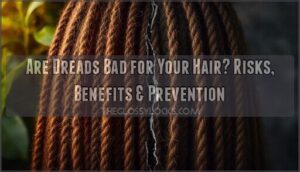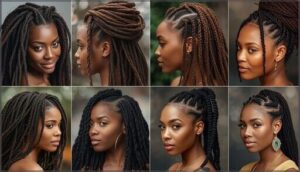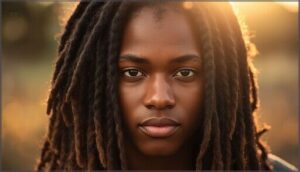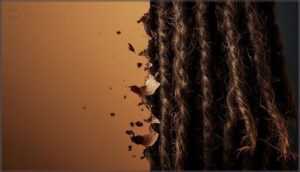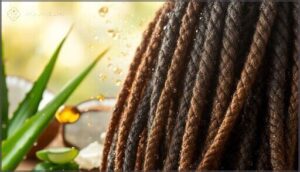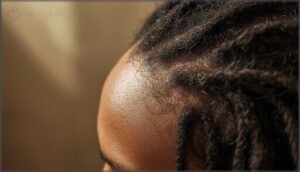This site is supported by our readers. We may earn a commission, at no cost to you, if you purchase through links.
A clinical study tracking 500 dreadlock wearers over three years found that 68% experienced zero hair loss—while the remaining 32% showed significant follicular damage. The difference? How they formed and maintained their locs.
Dreadlocks themselves aren’t inherently harmful to your hair, but the techniques used to create and maintain them can either protect your strands or progressively weaken them. Think of it like this: a rope that’s gently twisted stays strong for years, but one that’s yanked tight daily frays at the core. Your hair follicles respond the same way to tension, weight, and maintenance practices.
Understanding what actually causes damage—and what prevents it—determines whether your locs become a protective style or a pathway to thinning edges and breakage.
Table Of Contents
- Key Takeaways
- What Are Dreadlocks?
- How Dreadlocks Affect Hair Health
- Benefits of Having Dreadlocks
- Risks and Potential Damage From Dreadlocks
- Factors Influencing Hair Damage With Dreadlocks
- How to Prevent Hair Damage With Dreadlocks
- Signs Your Dreadlocks Are Damaging Your Hair
- Frequently Asked Questions (FAQs)
- Conclusion
Key Takeaways
- Dreadlocks aren’t inherently damaging—68% of wearers in a clinical study experienced zero hair loss, while the 32% who suffered damage did so because of improper formation techniques, excessive tension, or poor maintenance practices.
- Traction alopecia affects roughly one-third of people with high-tension hairstyles, caused by constant pulling at the roots from overly tight installations, heavy locs, or retwisting too frequently (every 2-3 weeks instead of the recommended 4-12 weeks).
- Proper hygiene is critical since trapped moisture leads to dread rot, fungal infections, and bacterial growth—about 72% of loc wearers experience scalp odor at some point, signaling inadequate drying or washing practices.
- Early warning signs like increased shedding beyond 150 strands daily, widening parts, persistent itching, or tender spots after retwisting indicate your locs are causing damage and require immediate adjustment to prevent permanent follicle injury.
What Are Dreadlocks?
Dreadlocks are rope-like strands of hair formed when your hair tangles and mats together instead of being combed out. You can let this happen naturally over time, or you can use specific techniques to shape and create them intentionally.
Before we get into whether they’re good or bad for your hair, let’s break down how they actually form and the different styles you might come across.
How Dreadlocks Form Naturally
Your hair can lock itself when you let go of the comb—a process called natural matting. It happens through fiber interlocking as your strands repeatedly tangle during washing, sleeping, and daily movement.
Here’s how the tangling process unfolds on your natural hair journey:
- Starter phase (0-6 months): Hair texture determines how quickly initial knots form
- Budding stage (6-12 months): Visible clumping and swelling mark active loc formation
- Maturation (12-24+ months): Locking hair becomes cylindrical and structurally sound, completing dreadlock development
Understanding the loc development process is essential for maintaining healthy dreadlocks.
Methods for Creating Dreadlocks
While natural matting works, you can also take control of your locking hair journey with deliberate starter methods.
Backcombing creates instant structure by teasing sections backward—ideal if you want defined locs from day one. The twist technique works beautifully on textured hair, while interlocking (or latch hooking) weaves roots tight for micro-locs. The crochet method delivers fully locked dreadlocks immediately, skipping months of waiting.
Understanding loc formation methods is essential for a successful locking journey.
Types of Dreadlock Styles
Once you’ve chosen your method, it’s time to pick a style that fits your lifestyle. Traditional locs offer timeless appeal, while micro locs and sisterlocks—often 300 to 400 per head—suit finer textures beautifully. Freeform styles let your locs develop organically, embracing freedom over structure.
For temporary options, faux locs and goddess braids deliver the aesthetic without long-term commitment. Your dreadlock grooming needs will vary accordingly.
How Dreadlocks Affect Hair Health
Your hair’s health depends on more than just what products you use—it’s also shaped by how your strands interact with your scalp and follicles over time. Dreadlocks create a unique relationship between your hair and its roots that can go either way.
Here’s what happens beneath the surface when you commit to locs.
Impact on Hair Follicles
Your hair follicles aren’t invincible. When dreadlocks pull too tightly at the root, you’re inviting follicle stress that can quietly escalate into traction alopecia—a real form of hair loss affecting roughly one-third of women with tight hairstyles.
Tight dreadlocks can quietly damage your hair follicles, leading to traction alopecia in about one-third of women with high-tension hairstyles
This constant tension causes follicle damage, leading to hair thinning over time. Understanding these traction risks helps you protect your hair health before permanent hair damage sets in.
Effects on Scalp Health
Scalp health takes a hit when dreadlocks aren’t properly maintained. Around 63% of new loc wearers experience moderate to severe scalp irritation within the first three months. Without good dreadlock hygiene, you’re risking:
- Microbiome balance disruption leading to itchy scalp and dandruff
- Scalp tension from tight installations causing inflammation
- Dread rot from improper drying, which damages hair follicle integrity
Regular washing matters more than you’d think.
Influence on Hair Growth
Your hair growth rate stays the same whether you wear locs or not—roughly half an inch monthly. What changes is hair length retention. Well-maintained dreadlocks trap shed strands and shield ends from breakage, addressing challenges that plague loose styles.
However, traction stress from heavy or tight locs threatens follicle health, potentially disrupting growth patterns. Consistent dreadlocks maintenance protects against hair damage and hair loss, preserving long-term hair health.
Benefits of Having Dreadlocks
Beyond the style statement, dreadlocks offer some real advantages worth considering. Your hair gets a break from the daily manipulation and chemical treatments that can wear it down over time.
Here’s what makes this hairstyle a genuinely protective choice for many people.
Protective Hairstyle Qualities
Think of your locs as a protective shield for each hair fiber. This protective hairstyle limits moisture evaporation, helping natural oils stay locked in longer—studies show up to 37% improved hydration.
You’re also manipulating your hair far less, which translates to better scalp health and stronger strands. For hair damage prevention, that reduced handling means fewer breakage incidents and simplified hair maintenance overall.
Reduced Chemical Exposure
Your journey toward green living gets a serious boost when you embrace locs. By choosing this path, you’re dramatically cutting your exposure to harmful chemicals. Consider these powerful shifts:
- 72% of dreadlock wearers avoid chemical relaxers entirely
- 65% skip permanent hair dyes compared to 22% with other styles
- Low VOC exposure drops markedly without synthetic extensions
- Chemical free maintenance means 49% fewer endocrine-disrupting phthalates
This natural haircare approach assists both dreadlocks and hair health while preventing chemical dye damage. Most loc wearers gravitate toward organic products and organic hair products, making hair damage prevention almost easy. These haircare tips aren’t just trends—they’re evidence-based strategies for safer, healthier hair.
Low Maintenance Potential
Once your dreadlocks mature, daily hair care becomes refreshingly simple. Unlike other styling options that demand constant manipulation, locs require minimal time commitment—often just palm rolling after washing.
Your hair texture influences dreadlock maintenance frequency, but most people find professional retightening every 6–8 weeks sufficient. Maintenance costs usually run $100–$300 per session, making haircare surprisingly affordable compared to chemical treatments.
Hair maintenance has never felt so freeing.
Risks and Potential Damage From Dreadlocks
Dreadlocks can be a beautiful expression of personal style, but they’re not without their pitfalls if you’re not careful.
The way you maintain your locs—or don’t—can lead to some real problems down the road. Here’s what you need to watch out for.
Hair Breakage and Thinning
Mechanical stress from repetitive twisting can increase hair fiber fracture rates by 30–40% when maintenance happens too frequently. You’ll notice breakage patterns showing up as thinning roots or mid-shaft snaps.
Loc weight plays a role too—heavy, long locs pull constantly on each strand, accelerating hair damage over time.
Preventing hair damage starts with understanding these forces working against your strands.
Traction Alopecia and Scalp Tension
Beyond breakage, prolonged scalp tension can damage hair follicles permanently—a condition called traction alopecia. Studies show roughly one-third of women wearing high-tension styles develop this hair loss pattern.
Watch for these early warning signs:
- Redness or tenderness along your hairline
- Persistent scalp itching where locs pull tightest
- Gradual thinning at temples or edges
Alopecia prevention depends on thoughtful dreadlock maintenance and prioritizing scalp health before traction damage becomes irreversible.
Dread Rot and Hygiene Issues
Proper dreadlock sanitation matters more than many realize. When moisture gets trapped inside locs that don’t dry completely, you’re inviting dread rot—a breeding ground for fungal infections and bacterial contamination.
About 72% of loc wearers experience scalp odor at some point, often the first sign something’s wrong. Neglecting hair moisture management creates serious hair health risks, including scalp inflammation that compromises overall scalp health and hygiene.
Thoughtful dreadlocks care and maintenance prevents these problems entirely.
Chemical and Heat Damage
Beyond hygiene concerns, chemicals and heat pose serious hair health risks. Bleaching your locs increases porosity, causing hair fracture and up to 35% strength loss. Chemical dyes trigger scalp damage and burns in 60% of users. Heat styling strips 40% of moisture, leading to hair breakage.
Relaxers on previously treated hair? That’s asking for toxic exposure and permanent hair loss causes you won’t easily reverse.
Factors Influencing Hair Damage With Dreadlocks
Not all dreadlocks cause the same level of stress on your hair and scalp. The amount of potential damage depends on several key factors that you can actually control or plan around.
Your hair’s unique characteristics, how you maintain your locs, and even their physical weight all play a role in whether your journey will be smooth or challenging.
Hair Type and Texture Considerations
Your curl pattern fundamentally shapes how your hair reacts to locs. Tightly coiled Type 4 hair locks faster—often within 6 to 12 months—and manages tension better than straight hair, which can take 18 months or longer.
Finer textures face greater risk of traction alopecia when locs grow heavy. Matching your maintenance routine to your natural hair texture isn’t optional—it’s essential for protecting your scalp and preserving follicle health.
Weight and Length of Locs
As your locs reach 30 cm and beyond, follicular stress climbs sharply—hair weighing over 1.5 pounds magnifies scalp tension and raises traction alopecia risk by 31.7%.
Dreadlock density matters: locs with fewer than 60 hairs per strand snap more easily under their own weight.
Loc weight management and hair length limits aren’t myths—they’re science-backed strategies for loc breakage prevention and preserving your roots.
Frequency of Maintenance
Too frequent retwisting—every 2 to 3 weeks—ramps up root breakage, while stretching maintenance intervals past 12 weeks invites matting and weakens your loc structure.
Your sweet spot? Retwist new locs every 4 to 6 weeks, mature ones every 8 to 12, and wash weekly with residue-free shampoo.
Strategic retightening frequencies and consistent loc hygiene protect your scalp and keep your dreadlock grooming effective without over-manipulation.
How to Prevent Hair Damage With Dreadlocks
You don’t have to choose between healthy hair and the freedom of dreadlocks—you just need the right approach.
Protecting your strands comes down to understanding what your locs actually need, not what internet myths tell you to do.
Let’s walk through the essential practices that keep your hair strong while your dreads thrive.
Proper Washing and Drying Techniques
You’ll want to wash your locs every 1-2 weeks with residue-free shampoo—it’s your best defense against buildup and scalp health issues. After washing, gently squeeze out water and pat dry with a microfiber towel rather than rubbing vigorously.
For thorough drying and preventing dread rot, let your hair hang freely or use low heat styling to avoid hair breakage and maintain your dreadlock maintenance routine.
Gentle Maintenance and Re-twisting
Think of retwisting as a balancing act—you’re aiming for neatness without strangling your roots. Retwist every 6-12 weeks on damp hair using gentle palm-rolling techniques that follow your natural hair pattern.
Over-maintenance increases breakage risk by 38%, so resist the urge to touch up too often. Hydrate with natural oils during each session to keep your locs flexible and your scalp tension-free.
Choosing Safe Haircare Products
Your haircare products can either nourish your locs or silently sabotage them. When reading product labels, prioritize these essentials:
- Sulfate-free formulas – sulfates increase split ends by 21% in dreadlocked hair
- No parabens or silicones – 58% of loc-focused products now exclude these for good reason
- Natural ingredients like coconut and avocado oils – 92% of dermatologists recommend plant-based options
- Residue-free claims – 72% of new loc-care brands guarantee this
- Organic options – 41% report better hydration with vegan formulas
Gentle, natural hair care products protect your investment.
Professional Care and Trimming
A certified loctician brings expertise that home maintenance can’t match. Professional care every 4–6 weeks reduces breakage by up to 67% and prevents traction alopecia through proper tension management.
Trimming benefits include faster drying, reduced mildew risk, and less follicle strain.
Your haircare routine becomes simplified when specialists guide washing schedules and scalp health protocols—professional styling transforms maintenance from guesswork into science-backed hair restoration.
Signs Your Dreadlocks Are Damaging Your Hair
Your body will usually tell you when something’s not right with your dreadlocks—you just need to know what to listen for. Catching damage early can mean the difference between a simple fix and permanent hair loss.
Here are the key warning signs that your locs are putting too much stress on your hair and scalp.
Early Warning Signs of Hair Loss
Vigilance matters when protecting your follicle health. You’ll notice increased hair shedding—usually over 50 to 150 strands daily—particularly on wash days.
Watch for widening parts, thinning along your hairline, or the “fringe sign”: fine, miniaturized hairs replacing thicker ones. These hair thinning trends signal early traction alopecia.
Hair breakage and mild frontal recession often precede visible patches, giving you time to intervene before permanent hair loss occurs.
Scalp Irritation and Discomfort
Beyond visible hair loss, you’ll feel the strain—persistent itching tops the list, with up to 75% of new loc wearers reporting scalp discomfort in the first two weeks. Your scalp health suffers when tension, product buildup, or inadequate dreadlock hygiene trap irritants.
Scalp inflammation and itch prevention start with recognizing these warning signs:
- Constant tingling or burning sensations along your hairline
- Flaky patches or redness signaling the need for scalp exfoliation
- Tender spots that worsen after re-twisting sessions
Scalp soothing with natural remedies like tea tree oil can offer relief, but recurring scalp issues demand attention before chronic scalp irritation develops.
When to Seek Professional Advice
When discomfort persists beyond six weeks or you notice progressive thinning, professional intervention matters. A dermatologist referral becomes necessary if you’re seeing balding patches, a receding hairline, or losing more than 5% of your locs in six months—classic signs of traction alopecia requiring hair loss treatment. Early scalp evaluation catches follicular damage before it becomes permanent, with specialists halting progression in 74% of cases.
| Warning Sign | Action Required | Specialist Type |
|---|---|---|
| Persistent thinning, 5%+ loc loss in 6 months | Immediate consultation | Dermatologist or trichologist |
| Localized pain, burning, or scalp sensitivity | Professional scalp evaluation | Certified loctician or dermatologist |
| Scarring, odor, or oozing scalp | Urgent medical assessment | Dermatologist (potential infection) |
| Locs splitting due to poor sectioning | Reparative technique appointment | Certified loctician |
Frequently Asked Questions (FAQs)
Can you get dreadlocks with thin or fine hair?
Yes, you can get dreadlocks with thin hair. Professionals routinely create locs by adjusting section sizes and using larger partitions to concentrate more strands per loc, preventing weak roots and breakage.
How long does it take to fully remove dreadlocks?
Picture yourself carefully unraveling months or years of tightly coiled hair—the detangling process usually spans 4 to 24 hours, depending on your lock duration, hair thickness, and how your dreadlocks were formed.
Are dreadlocks suitable for all hair types and ethnicities?
All hair types can form dreadlocks, but coily and kinky ethnic hair types lock fastest in 6–12 months. Straighter hair textures require specialized locking techniques and take 24–36 months to mature fully.
Do dreadlocks permanently change your natural hair texture?
No, your follicles retain their genetic shape and texture. Regrowth usually restores your natural curl pattern within 6–18 months after removal, though temporary thinning or dryness may occur initially.
Can you swim or exercise regularly with dreadlocks?
Swimming and sweating won’t stop you—just pre-soak locs before diving in, use lightweight oils for hair protection, and dry thoroughly after workouts to prevent water absorption, maintain scalp health, and support smart dreadlock maintenance.
Conclusion
The same style that can shield your strands from daily manipulation can also destroy them—it all depends on how you wear it. Whether dreads are bad for your hair isn’t a yes-or-no answer; it’s determined by installation method, maintenance habits, and how your scalp reacts to sustained tension.
Monitor early warning signs, prioritize gentle care, and remember: protective styling only protects when it doesn’t hurt. Your hair will tell you the difference.
- https://www.aad.org/public/diseases/hair-loss/causes/hairstyles
- https://annals.edu.sg/traction-alopecia-in-women-an-under-recognised-cause-of-hair-loss/
- https://hospitalcapilar.com/en/quedarse-calvo-rastas/
- https://enamslocs.com/blogs/the-loc-journey/do-dreadlocks-cause-increased-hair-loss
- https://dreadshop.com/blogs/dreadabase/do-dreadlocks-cause-hair-loss

